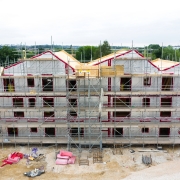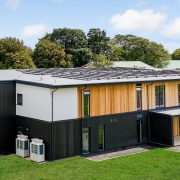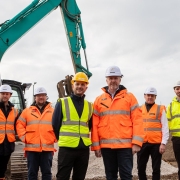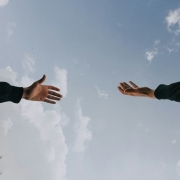Barfield Prep School welcomed a visit by the mayor of Farnham, Cllr Alan Earwaker, to open its new dining hall on Monday, April 22. Sustainable construction firm TG Escapes designed and built the new hall using modular construction methods in just four months, allowing children to continue their education.
Algeco UK OSS has shared behind-the-scenes images of its latest 75-bedroom Single Living Accommodation (SLA) complex at the Ministry of Defence (MOD) Stafford. The company has delivered a full turnkey solution, acting as Principal Contractor to the Defence Infrastructure Organisation (DIO) and the British Army.
Modern Methods of Construction (MMC) refers to offsite and onsite techniques, which could include mass production and factory assembly as alternatives to traditional building methods. These are a fast way of delivering new buildings focused on the efficiency of materials and human resources. Modular buildings devised utilising MMC have the potential to deliver significant improvements in productivity and quality for both the construction industry and the end user. They also minimise the work required on-site, which can have added benefits and appeal for those in sectors such as Defence.
The solution provided to MOD Stafford is a CTM Leve1 (Category 1) Pre-Manufacturing 3D primary structural system that will be used to house members of the army. The three-storey building, known as Beacon Barracks, is set to offer high-quality accommodation with integral communal areas, as well as a brick slip façade and sustainable features including solar PV and heat pumps. The modules for the barracks were manufactured in Carnaby in East Yorkshire and delivered to the site with a Pre-Manufactured Value (PMV) of around 80%. MOD Stafford was designed by AHR Architects, supporting the Algeco UK OSS team on the construction stage and architectural design through its Leeds offices.
A full site inspection has now been carried out with strong feedback received by attendees and participants, particularly regarding the overall quality and feel compared to comparative schemes. Volumetric Air tests are carried out on all completed projects and the SLA Block at MOD Stafford has achieved a rating of 1.18. Lee Kenton of Build Energy commented that 1.18 is “exemplary for the size of the building” and “far exceeded” the Passivhaus gold standard of 0.60, with an air change rate of 0.48.
The new barracks at MOD Stafford is part of an £800M investment into SLA by the Army over the next decade. This investment into modern infrastructure is set to provide military personnel with the fit-for-purpose accommodation facilities they deserve, as well as contribute to ambitions to become Carbon Net Zero by 2050.
Brigadier Pete Quaite, head of army infrastructure plans, said: “I visited the Single Living Accommodation under construction at Beacon Barracks at the start of this year. To see the finished block just two months later shows the impressive pace of progress being achieved through our modular design and build programme. This new SLA is another excellent example of how ongoing Army investment is improving the quality of life for our people, providing them with modern, spacious and well-designed accommodation.”
Wayne Yeomans, Algeco UK OSS sales and marketing director, added: “This is modular and offsite construction at its best. I must applaud the Algeco UK team as well as our supply chain partners, including AHR Architects, for making this possible. Working with architects means we have incorporated innovative features into the design, such as solar PV orientation to maximise the amount of electricity produced and optimising the number of overall modules required.
“We were selected as the modular building partner by the MOD because of our track record in supplying high quality accommodation on a diverse range of other publicly funded projects, along with our willingness to collaborate with project partners and deliver excellent value for money. “The quality of these solutions is proven by results, like the industry-leading scores achieved in our recent volumetric air test, which is not an easy achievement. We have learnt so much from this project and we are proud this will also help inform the Defence Infrastructure Organisation’s future Programmatic Design approach.”
The report “Modular Construction Market by Type (Permanent, Relocatable), Module, Material (Wood, Steel, Concrete), End-Use Industry (Residential, Office, Education, Retail & Commercial, Hospitality, Healthcare), Region – Global Forecast to 2029” estimated the global modular construction market size will grow from USD 104.1 billion in 2024 to USD 140.8 billion by 2029, at a CAGR of 6.2% during the forecast period.
The modular construction market is growing rapidly due to urbanization, population growth, and the need for faster, more efficient building methods. Technological advancements have enhanced the quality and customization options of modular buildings, making them increasingly popular. Additionally, the focus on sustainability drives the adoption of modular construction, which generates less waste and requires fewer resources compared to traditional methods. However, factors such as lack of awareness and volatility in transportation charges may stall the growth of the market.
Permanent modular building is estimated to dominate the market
The modular construction market is categorized as permanent and relocatable. Permanent modular buildings are reported as having the largest market share in the modular construction market. Permanent modular construction saves time and labour, thus lowering the construction cost.
Steel is projected to be the fastest growing segment in the modular construction market
Steel is the fastest-rising segment for the modular construction market from 2024 to 2029, in terms of value. This is because of the increasing use of steel in construction activities. Steel is also lighter in contrast to other materials, which makes it easy to be craned and transported into a place in a more efficient manner, resulting in less disturbance to the local area.
The residential segment is expected to dominate the modular construction market.
Residential building structures can be built using modular construction solutions in about half the time as compared to conventional site-built construction methods. Different countries are turning to the adoption of modular construction methods as the modular construction helps in waste reduction during the construction process as the different modules are made in-factory. The residential end-use industry reported the most substantial demand for modular construction in 2023, in terms of value and volume.
Asia Pacific is the largest market for modular construction.
The Asia-Pacific (APAC) region emerges as the largest market in the modular construction industry among APAC, North America, Europe, the Middle East & Africa (MEA), and South America, primarily due to several key factors. Construction, one of the biggest and most valuable manufacturing sectors in the region, is highly fragmented and consists of a considerable number of large, medium-sized, and small construction companies. The construction players in the industry have adopted various technologies as a strategy to sustain the growing demand and competition. Rapid urbanization, industrialization, and expanding middle-class populations in countries like China, India, and Southeast Asian nations contribute significantly to the region’s dominance in the market. Furthermore, increasing urbanization has led to changes in lifestyle and consumption patterns, driving the need for independent housing units.
TG Escapes provide timber frame, net-zero buildings offering a highly flexible, bespoke, turnkey, architectural design and build solution to a wide range of customers. Biophilic design principles are combined with sustainable materials and the latest technology to create buildings that are beautiful, ergonomic and inspiring for their occupants whilst offering exceptional environmental integrity. One of their more recent projects was commissioned by Brune Park Community School which is part of the Gosport and Fareham MAT.
The school needed to replace an old SCOLA building, which had poor insulation values and provided an uncomfortable learning environment. They selected TG Escapes to design a building providing flexible classroom space, including conferencing facilities to also act as a local community business hub. The building includes nine classrooms which can be opened up, breakout and office spaces and a large atrium.
GFM were keen on an operational net-zero solution and were impressed by TG Escapes understanding of their requirements. They also considered a volumetric and traditional build but the timescales didn’t suit. The building, completed in 26 weeks onsite, achieved an A+ EPC at minus 3 at a cost of £2.8m including demolition, temporary construction and external landscaping.
Kevin Rochester, Head of Estates at GFM says;
“The green aspect is a big plus for us now that we are trying to move into the world of sustainability. We also just felt in the commissioning process TGE were really enthusiastic about the project as a flagship building whereas the others seemed to see it as just another project. The other buildings were also fantastic but TGE had the eco thing and the chemistry was right.”
Andrew Cowlard, Associate Director at MEB Design acted on behalf of GFM as contract administrators;
“I found that it was very positive because in our role, a traditional job is a lot more involved. And because TGE offers a one-stop-shop solution with their own project management, they almost manage it all themselves so there was less involvement required from my side. Overall it was quite seamless.”
Kevin Rochester;
“I am delighted with our experience of TG Escapes, from the initial tender exercise right through to the successful completion of the build. They have maintained an exceptional standard of communication throughout the project which has facilitated a smooth collaboration. Their prompt and professional response to queries has significantly contributed to the efficacy of the entire process and we commend TG Escapes for their unwavering dedication to adhering to the project timeline.
Operating within a bustling school environment, the absence of conflicts between the contractors and the broader GFM School community is a testament to their ability to seamlessly integrate their operations. The meticulous attention to detail is evident and speaks to their commitment to excellence. Their team’s courteous and respectful demeanour has made collaboration a true pleasure.”
At the recent opening of the building, senior staff and board members commented;
“We have both single classrooms and open classrooms enabling us to teach in creative ways. The large amounts of glass and open plan spaces allow us to see the outside and bring that outside into the classroom which is always really positive for mental health and well-being.”
“It is also an eco-friendly building that sustains its temperature, provides a sustainable environment for learning and creates a space that people actually want to learn in.”
“This building is very special, it is a landmark in Gosport already and it will certainly be a focal point for Brune Park School.”
TG Escapes have produced hundreds of school buildings including SEND facilities, classroom blocks, dining halls and drama studios. The biophilic approach ensures that these spaces are full of natural light and have easy access to the outdoors. The impact on students is pronounced, with a calming effect that helps to reduce stress and increase focus. The buildings are often seen in SEND and SEMH settings, providing a range of specially designed spaces intended to benefit students with diverse needs.
They have been recognised by several prestigious bodies, winning “Project of the Year” and “Public Sector Innovator of the Year” at the 2023 Modern Methods of Construction Awards, alongside “Contractor of the Year” at the 2021 Education Estates Awards. Clients rate them 4.9 out of 5 from over 187 customer reviews.
Working with TG Escapes is a simple process that starts with a complimentary site visit and a bespoke design. From small classrooms to larger buildings, ranging in price from £300k to over £6m, the team designs and installs beautiful, sustainable, and positive spaces for all educational needs.
For more information and case studies, call 0800 917 7726 or email info@tgescapes.co.uk.
www.tgescapes.co.uk
Specialist low carbon developer and modular manufacturer Starship is bringing forward a project in Wallasey, Wirral, which is set to be one of the largest modular carbon zero housing developments in the North West.
In partnership with North West housing association, Onward Homes, and supported by Homes England and the Liverpool City Region Brownfield Land Fund, which has allocated £195,000 to the project, Starship will deliver 13 carbon zero homes across a 64,000 sq ft site in Wallasey.
Constructed using low carbon Modern Methods of Construction (MMC), the Greenleas project will use eco-friendly construction methods by prioritising energy efficiency from the start of the design and development process.
Situated on undeveloped land at the bottom of Greenleas Close in Wallasey, the three-bedroom homes will be built with strong eco-credentials, holding an impressive EPC rating of A.
Onward Homes is one of the largest providers of social housing based in the North West, with more than 35,000 homes across the region. This development is Starship’s first project with Onward Homes and is expected to be completed in just over 40 weeks.
The MMC homes will be built in Starship’s Wirral Waters based factory, with each home taking a week to build and a day and a half to be erected on site.

Image credit: Starship
Dave Dargan, co-founder and chief executive of Starship, said: “At Starship, we are purpose driven to build better, and we have a strong commitment to low-carbon living, ensuring that everything we do is led by our commitment to the green agenda.
“Forming a partnership with Onward Homes is an exciting opportunity for us to continue delivering gold-standard, carbon zero homes and developing long-lasting communities with sustainability at their core. Greenleas will become a fantastic new addition to Wallasey, providing people with modern homes in the heart of one of Wirral’s most up and coming areas.”
Bronwen Rapley, chief executive of Onward Homes, added: “Onward is committed to becoming a leading environmentally-friendly landlord across the North West, providing warm and affordable homes in greener neighbourhoods for our customers to enjoy. Starship’s cutting-edge homes promise to make a real difference in this part of Wallasey, helping local people take their first steps on the property ladder while ‘treading lighter’ on the local environment through sustainable design and manufacturing.”
Cllr Graham Morgan, Liverpool City Region portfolio holder for housing and spatial planning, said building on brownfield sites was a central part of plans “to ensure there is a great choice of high-quality homes, right across the city region, as part of our ambitious plans to tackle the housing crisis.”
Around 21 modular specialists face a fight to retain places on the next-generation modular building framework for NHS Shared Business Services.
The rebooted framework has been expanded to cover new sectors, doubling the expected workload over the next four years to £3.6bn.
For the first time, it will include a hybrid construction/modular lot, where the general construction works element accounts for over £60m of the project value.
This is expected to attract JV bids from mainstream modular specialists of the kind successfully adopted by Kier and McAvoy on the Crown Commercial Services deal awarded last year.
The lotting structure for the NHS SBS, which includes local authorities, will also see the introduction of residential and blue light sectors, while a specialised kitchen lot is dropped.
The new arrangement will come into force when the existing deal expires in 2025. Since the existing framework was launched 8 firms have dropped out or collapsed from the original 29 companies selected.
Lambeth Council, working closely with a leading youth homelessness charity, aims to broaden the housing landscape for young working people struggling to find affordable accommodation in the borough.
The council’s proposal involves a 60-year term lease agreement with Centrepoint to develop 18 units of high-quality, affordable homes, catering specifically to employed young people aged 18 to 24.
For years, the pathway for young individuals moving on from supported housing services has been fraught with challenges, leaving many in limbo for extended periods. Recognising the need for a sustainable solution, Lambeth Council has embarked on this innovative project that promises not just to provide working young people with a home, but to support them as they continue their housing journey. The proposed single occupancy units will not be homeless accommodation.
This initiative comes at no capital cost to the council and is expected to generate significant revenue savings by reducing the costs associated with Temporary Accommodation. The off-site constructed homes will occupy Charter’s Close in South-East London.
The site, disused for over a decade, presents an ideal opportunity to make a tangible difference in the lives of young people striving for independence and stability. The proposed homes, to be built with the financial backing of Centrepoint, will offer young residents a unique chance to live affordably, paying rent at only one-third of their annual salary. This model not only ensures affordability but also encourages savings for their future.
The selection of Charter’s Close for this project underscores Lambeth Council’s commitment to using unused land resourcefully, transforming it into vibrant living spaces for those in need. The off-site construction method promises efficiency and minimal disruption, with the potential for residents to move in by Winter 2025.
This partnership with Centrepoint highlights a proactive approach to addressing youth homelessness and the broader housing crisis, offering a replicable model for other councils facing similar challenges. This comes at a time when Centrepoint’s own research demonstrates that many private landlords are unwilling to rent to young people. The scheme embodies Lambeth Council’s dedication to supporting its younger residents, ensuring they have access to safe, affordable housing within the borough, close to their work, and support networks. Centrepoint will submit a formal planning application and as part of this process, local residents and stakeholders will be invited to take part in a consultation.
LoCaL Homes, an award-winning advanced offsite housing manufacturing facility in Walsall, recently received a high-profile visit from a trio of Tory politicians.
Mayor of the West Midlands, Andy Street CBE, Cllr Adrian Andrew, Deputy Leader of Walsall Council, local MP Wendy Morton (Aldridge-Brownhills) and their staff were given a tour around the LoCaL Homes factory to learn more about modern methods of construction (MMC) and the products which LoCaL Homes manufacture.
Mike Doolan, Sales and Partnership Manager at LoCaL Homes, chaired a discussion with the visiting delegation around the future of closed panel timber frames and the opportunities and barriers in housebuilding using MMC.
He said: “It was fantastic to welcome Andy Street CBE, Cllr Adrian Andrew and Wendy Morton MP to our manufacturing site in Walsall.
“I was proud to show our visitors the high-quality timber frame panel we make in the heart of the Black Country and demonstrate how they have been used to build homes in the West Midlands and beyond.”
The visit comes ahead of the introduction of the Future Homes Standard – a set of rules which will ensure that new homes built from 2025 produce 75-80% less carbon emissions. LoCaL Homes is already manufacturing its Eco-200 timber frame panels for a number of developments housing associations and contractors across the country to achieve the standard ahead of time.
Andy Street, Mayor of the West Midlands, added: “Housebuilding has been one of the West Midlands’ best success stories in recent years, with record numbers of homes being built, the vast majority of them on brownfield land. This has kept us on course to achieve our target of building 215,000 new homes by 2031.
“But as we look to continue that success we must also think about how housebuilding can help tackle the climate emergency and support the region’s ambition to be net zero by 2041.
“We want to see greater use of Advanced Manufacturing in Construction so we can not only build homes faster but more sustainably.
“It was fascinating to see LoCaL Home’s manufacturing process. It is a wonderful example of West Midlands innovation and exactly the sort of approach to construction that can not only build a cleaner, more sustainable economy but also create the hi-tech, green industries of the future, creating well-paid and secure jobs for local people.”
Wendy Morton MP said: “At the end of a busy week in my constituency, it was great to visit LoCaL Homes in Aldridge. They excel in manufacturing offsite solutions for various buildings such as bungalows, houses, apartments, care homes, and schools.“LoCaL Homes are shaping the future of housing solutions, and providing local skills employment opportunities.”
Residents of Lockleaze, Bristol, are facing the stark realities of modular construction gone awry. A development promising a faster, greener, and cheaper housing solution has turned into a prolonged nightmare, as homes built using modern prefabricated techniques face dismantling due to foundational flaws. This setback not only disrupts the lives of local residents but also casts a long shadow over the future of prefab housing in the UK. Despite governmental support, including hundreds of millions in funding, the industry struggles with demand, leading to significant financial losses and the closure of key players like Legal & General Modular Homes.
Challenging Conventions: The Prefab Predicament
The ambition to revolutionize the housing industry with prefabricated homes has encountered numerous challenges. From local opposition to restrictive planning systems, prefab ventures like the one at Bonnington Walk reveal the complexities of modernizing construction methods. The government’s strategy, criticized for its lack of coherence and direction, further complicates the transition to modular construction. With public and private investments yielding limited success, the dream of mass-producing affordable, quality homes remains elusive, raising questions about prefab’s viability as a solution to the housing crisis.
Future Foundations: Reimagining Residential Construction
Despite the setbacks, there is still hope for the prefab housing sector. Innovations and successes abroad suggest that with the right conditions, modular construction could play a significant role in addressing housing shortages. However, overcoming the industry’s current challenges will require a concerted effort from the government, manufacturers, and the public. As the UK grapples with the need for a more efficient, sustainable housing model, the story of Bonnington Walk serves as a cautionary tale, highlighting the necessity for strategic planning, investment, and public support to realize the potential of prefab housing.
Work is due to begin on developing seven new one-bed small homes as Places for People expands its homelessness accommodation and support services for homeless people in Bristol.
Places for People have operated supported accommodation at Stonebridge Park for over 23 years providing support and accommodation to vulnerable homeless men.
The current accommodation offers 27 living spaces with on site support to help customers through their journey out of homelessness.
In September 2023, Places for People along with our delivery partner Agile Homes were successful in securing planning permission to build seven small self-contained modular homes on the existing site at Stonebridge Park, which will allow people to live independently with their own kitchen space, living area, bathroom and bedroom.
Work is now set to begin building the small homes, which will overlook the Clay Bottom Valley and Nature Reserve and they are due to be completed by October 2024. This comes after Places for People worked with the Hill Group and Bristol City Council to open 8 similar modular homes on Derby Street in January.
In addition to somewhere safe and stable to live, the facility also provides those living there with support around a vast number of complex issues which may have contributed to them becoming homeless such as mental health, domestic abuse, financial and drugs or alcohol. Support workers then help customers on their journey back into permanent accommodation.
Rachel Crownshaw, Group Managing Director for Communities at Places for People, said: “It’s really pleasing to see work begin on what is going to be such an important development. These modular homes will allow us to build on the great work we’re doing to support people in Bristol who are experiencing, or at risk of, homelessness.
“Really importantly, these new homes will provide people with somewhere to call home, where they can live independently, with their own front door and everything they need inside. In addition to this, we have support workers available who can work with those living here and give them support, advice and guidance as they get back on their feet and hopefully into more permanent accommodation.
“We have been supporting people who are homeless, or are at risk of being homeless, for many years. We work with young people, families, and single adults right across England and Scotland providing critical housing, support and services that aim to help those who are experiencing difficulties back into a more stable and secure situation. For example, we have provided over 200 supported accommodation properties across Bristol alone. Our country is in the teeth of a housing crisis, and we will continue to increase the support and services we provide to ensure we are doing as much as we can.”
MMC is published by Waverley Publications Limited
Registered office Sibrwd Y Dwr, Station Road, Llwyngwril, Gwynedd, LL37 2JS
Reg. No. 13018966
Pages
Categories
Archive
- December 2025
- November 2025
- September 2025
- July 2025
- May 2025
- April 2025
- March 2025
- January 2025
- December 2024
- November 2024
- October 2024
- September 2024
- August 2024
- July 2024
- June 2024
- May 2024
- April 2024
- March 2024
- February 2024
- January 2024
- December 2023
- November 2023
- October 2023
- September 2023
- August 2023
- July 2023
- June 2023
- May 2023
- April 2023
- March 2023
- February 2023
- January 2023
- December 2022
- November 2022
- October 2022
- September 2022
- August 2022
- July 2022
- June 2022
- May 2022
- April 2022
- March 2022
- February 2022
- January 2022
- December 2021
- November 2021
- October 2021
- September 2021
- August 2021
- July 2021
- June 2021
- May 2021
- April 2021
- March 2021
- February 2021
- January 2021
- December 2020
- November 2020
- October 2020
- September 2020
- August 2020
- July 2020
- June 2020
- March 2020
- February 2020
- January 2020
- December 2019
- November 2019
- October 2019
- September 2019
- August 2019
- July 2019
- June 2019
- May 2019











